Jul 27, 2021
COMPARE A JUMBO JET TO OPEN DECKING
You’ve flown. Whether it’s 100 or 1,000 miles, it’s the same principle.
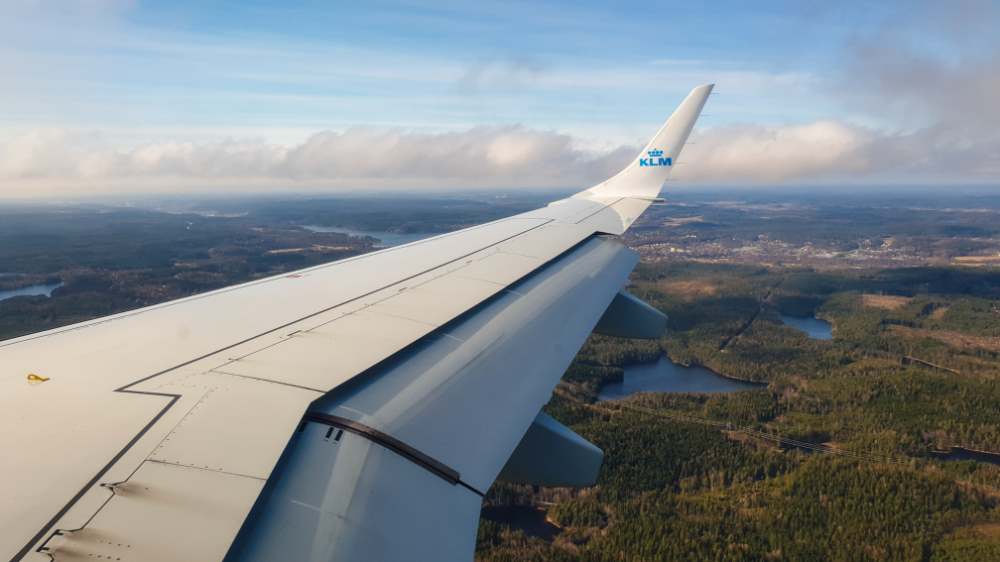
Airplane Flaps
Credit: Miguel Ángel Sanz
While landing at 125 MPH, a plane uses its “flaps” to provide extra “lift” when the forward speed is insufficient to keep the aircraft in the air. Flaps are those pieces of metal that roll out of the wing to slow the plane down while providing extra lift.
The added “lift” caused by the extended “flaps” maintains enough “lift” and surface area to keep the plane flying for a controlled landing.
What if the flap resistance was reduced to less than 60%?
What would happen if the flaps had “holes” in them. If you reduced the surface area by over 40%, what would happen? The answer is simple – the plane would soon be a pile of scrap metal.
By reducing the surface area of the flaps, air would pass right through, and the “lift” the pilot needed to stay airborne would disappear.
A plane needs the flaps’ resistance to help slow the aircraft when landing to maintain control.
The idea of resistance against the flaps works great for an airplane – not so much for your dock.
What has that got to do with open decking?
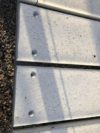
Typical Plank decking
That same principle of “lift” applies to your dock. Older docks have wood, aluminum, or plastic board decking. Despite the 1/2″ opening between the deck pieces, the decking is essentially a solid mass. When a wave comes up under the decking, the water tries to push the decking up.
Here’s where you have a choice.
With bolted-down decking, the wave is trying to lift the entire structure.
If you leave the decking loose, you risk losing that piece(s) of decking. Sometimes the pieces float a short distance and sink. You can recover them with a bit of effort.
The other side of the coin is they float too far away, and you end up purchasing new pieces.
What about “open decking”?
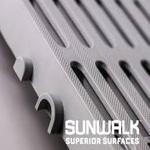
Open Decking
The open decking is like the “flaps” with holes in them. There is so much less surface area- 42% less – that the “lift” pressure is greatly reduced. The likelihood of lifting or flipping your dock over is significantly reduced.
We have to salvage many of the bolted down, solid plastic docks when the end lifts up and flips over. Usually, this causes the entire pier to flip over.
It’s like a train where the lead cars go off the track. Because they are connected to the next car, they all (or mostly all) flip over. The same is true with a dock.
You end up with twisted frames, which are a complete loss.
Is open decking hot to walk on?
No, for the same reason they are less likely to “lift” the dock. Those holes or slots rapidly dissipate the heat. The air passes through them and takes the heat away.
Does it get slippery when wet?
The shape of the slots allows the water to run off. The decking does not get “cupped,” which holds the water like the solid plastic boards. Besides, there are dimples on the walking surface to add traction.
It looks hard to walk on.
No, most people find open decking comfortable to walk or lay on.
Summary
Besides all the benefits noted above, the open decking costs LESS than other types of decking. These benefits are yours when you buy open decking from PWS.
Now pair these benefits with the PWS 3-Season Pier, and you have the best value for your money.
Call Jerry today. (920-493-4404) or jerry@wisconsinpws.com
Tell Your Friends & Family
Have friends or neighbors you believe should see this article? Email them this link – and Thank you!
Visit Pier & Waterfront Solutions on Facebook.
Where is Pier & Waterfront Solutions?
Located at 7325 St. Hwy 57, it’s 3 miles south of Sturgeon Bay and 1 mile past the intersection of Cty MM (heading north). Look on the right side, one mile north, at the next corner (Idlewild Road and Hwy 57).
Is PWS OPEN?
Pier & Waterfront Solutions has remained “open.” We have implemented measures to ensure the safety of our employees and visitors. At the same time, we are working to maintain the trusted service that you have come to expect.
PWS implemented these precautionary measures:
1. Conducting as much business as possible by email, text, or phone.
2. Site visits will continue. When in-person contacts are necessary, we will follow “social distancing” guidelines.
3. Our display yard is always open for you to examine at your leisure. All displays have a numbered, red tag on them. If you want more information or pricing, please reference that number.
What can YOU do to help us?
1. Please conduct as much business as possible via emails, messaging, and emails. This step protects everyone involved.
2. When you see our crews installing equipment, please practice “social distancing.”
Thank you for allowing us to work with you.
YES – PWS is OPEN and waiting for you!
Please call, message, or email PWS with any questions.
Let’s all stay safe!
Dec 8, 2020
Does High Water require the 3-Season Pier?
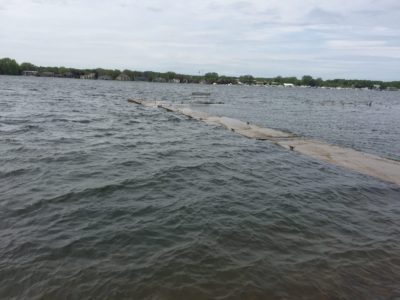
High water over the dock
High water continued again in 2020 and many people looked for a stronger, more durable pier for 2021.
After 2 years of design improvements, the 3-Season Pier was introduced in 2020. It was a hit and sold out quickly.
Looking for a new pier?
In the early part of the 2020 boating season, the number of washed-out docks increased substantially. Storms raged throughout the boating season.
There are many brands of docks on the “Bay”. Every brand was represented in the list of docks & piers damaged or destroyed this year. That is, except the 3-season pier. It also withstood the Lake Michigan turbulent waters.
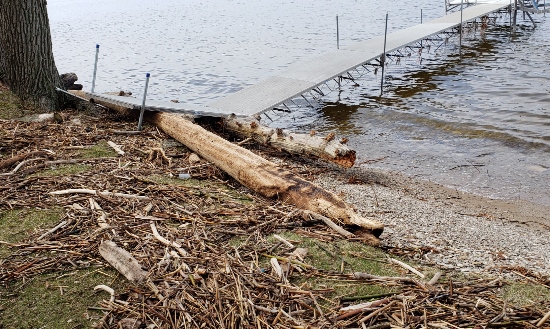
High water and debris
During 2020, many people saw floating debris during and after the storms. The debris moved along the shoreline. In some cases, uprooted trees and logs were responsible for taking out docks and lifts. The debris continued to move long distances before it finally settled on the shore again.
Now, we don’t represent that a 3-Season Pier will completely stop damage like that. But there is a much better chance of a 1/4 ton pier (per section) with 2″ galvanized steel legs (2-3/8″ O.D.) withstanding the force of the waves. Compare that to the 1-1/2″ leg (1-7/8″ O.D.) used on lesser, lighter docks.
Why did high water prompt a new design?
Over the years, PWS realized that having strong steel legs was not enough for the current situation. We watched helplessly as the waves lifted the dock sections. When the dock section came down, they seldom came down evenly or level.
As waves battered the bottom of the pier, it twisted the dock frames and caused the legs to bend sideways as the dock comes down.
Once the legs bent, the entire structure was subject to rolling over. There had to be a way to reduce the pressure on the docks.
We quickly realized that solid decking was our worst enemy. With solid decking bolted to the frames, the full force of the waves had to be absorbed by the dock.
After research, we found that a deck that allows the water to flow through the decking was the best possible answer. We quickly introduced the ShoreMaster Glacier™ flow-through, open decking on our aluminum piers.

Sunwalk Decking
High water requires Sunwalk Decking™
When the galvanized steel, 3-Season Pier, was introduced, it included Sunwalk™ decking. After securing the decking to the frames with stainless steel screws, the 45% open area allowed most of the energy of the water to flow through the deck harmlessly.
Combining the 1/4 ton weight per 20′ section with a 45% open decking, and you have a winning combination.
Higher Water needed Longer Ramps too!
However, we did not stop there. We also realized that the piers had to be set high to reduce the number of times the waves could hit the decking. This created a problem. The short ramps going to the pier were too steep for people to comfortably walk up.
We designed a 20′ long ramp, thus making a gentle approach to the pier. The shore end includes built-in leg pockets to raise the ramp off the beach. These added legs allow any waves that get to the end to pass harmlessly under the frames.
When should I start looking for a new pier?
Now is an excellent time to research the features of the 3-Season pier and place a preseason order. It’ll be ready when you are in Spring. Don’t forget, we can take trades, too.
The exclusive 3-Season Pier is available only at Pier & Waterfront Solutions.
Conclusion
PWS has the best solution for your 2021 dock.
Call Jerry at Pier & Waterfront Solutions (920-493-4404) for more information.
Where is Pier & Waterfront Solutions?
Located at 7325 St. Hwy 57, it’s 3 miles south of Sturgeon Bay and 1 mile past the intersection of Cty MM (heading north). Look on the right at the intersection of Idlewild Road and Hwy 57.
ARE WE OPEN?
Pier & Waterfront Solutions remains “open.”
We have implemented measures to ensure the safety of our employees and visitors. At the same time, we are working to maintain the trusted service you expect.
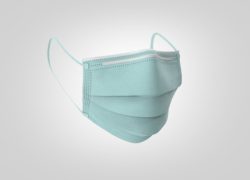
Please use face masks
Because the virus has increased its spread, PWS is conducting as much business as possible by email, text, or phone.
Site visits continue as usual. When in-person contacts are necessary, we follow “social distancing” guidelines as closely as possible.
Display yard – OPEN
Our display yard is always open for you to examine at your leisure. All displays available for sale have a numbered, red tag on them. If you want more information or pricing, please reference that number when you call.
We provide estimates and quotes by email to make the process paperless, faster, and safer. Everyone should feel safe with these measures. Let’s get back to normal operations quickly.
What can YOU do?
Please conduct as much business as possible via emails, messaging, and phone. When you see our crews on-site, please practice “social distancing.”
Call, message, or email us with any questions.
Thank you for allowing us to work with you safely.
Let’s all stay safe!
Jul 7, 2020
Do I need a new dock?
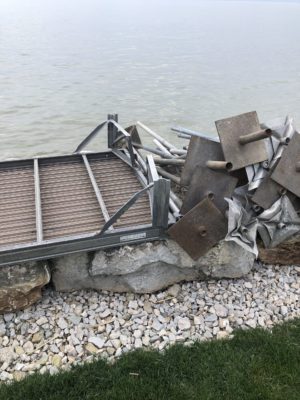
Do I NEED A NEW DOCK?
Docks that are several years old will show some signs of wear. It might be the decking, or it could be the frames. Either way, your dock needs yearly inspections. It’s especially true this year.
Why? You guessed it – the storms. At least two things are happening. Record-setting water levels mean the waves can dislodge trees, logs, and other floating objects that have been sitting dormant on the shore for years. They get washed along the beaches and could hit your dock or boat lift during a storm.
Other docks or decking from your neighbors’ pier can be washed out too. That debris could also hit your dock. Don’t forget about the jet skis and boats that get dislodged in the significant storms.
How many times does it take to cause damage to a dock or boat lift?

Dock damage
Once could be enough. Imagine a boat or log floating under your dock or into your boat lift. The next wave pushes it up against the bottom of your dock or lift. With the wood hung up under the frames, they get twisted by the waves. Here’s the result.
Is the hardware still holding tight?
At one point, at least one manufacturer’s decking was glued and stapled. This decking did not have enough support under the decking, either. The constant flexing of the panels and the natural wood shrinkage meant the staples loosened, and the glue let go.
Consider replacing a wooden decked pier with a different material. If the frames are sound, you may be able to use the Flow-through decking options.
Flow-Through decking is considered the best decking available. For more information, click HERE.
What about the frames?
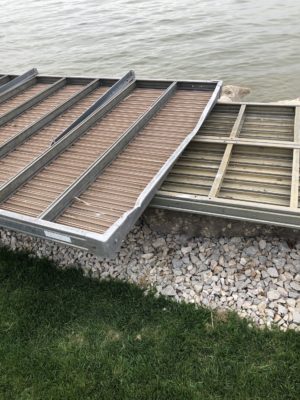
Is your dock frame bent?
How much wear and tear is the question. Proper maintenance of a dock system can help keep it looking beautiful for a long time. Some types of damage are easily repaired. Others need a lot of work.
But, if your dock is getting dangerous and unreliable, replacement might be the best option. Here are some more signs that you should think about investing in a brand new dock.
Widespread Rust
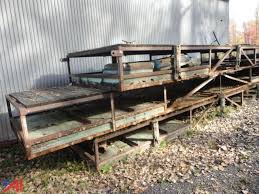
Do I need a new dock?
Certain types of metal used around water will rust. Painted, and even powder-coated metals will need regular upkeep to keep ahead of the rust.
Large areas of rust will spread. They eat away at the dock frames. If the metal rusts through, it can cause breakage in other areas too.
In cases like this, a completely new dock might be necessary.
Aluminum docks are made of rustproof metal and are a great option when considering upgrading or replacing a failing dock.
Have wood – will rot, Discolor, Split … You get the point!
Wooden docks can rot when water seeps into the wood. Moss, mildew, algae, and other growth can trap moisture in the wood decking, worsening the situation. However, it can be solved or prevented by keeping your dock clean and well maintained.
If a small area is experiencing rot, replace the individual components with new, treated lumber. But, when multiple areas are rotting, it’s time to replace your dock.
Consider replacing a wooden pier with different materials, including aluminum painted to look like wood, which is one of the premium ShoreMaster decking options.
Cracked or Warping Dock Supports
Has any boat come in “hot” (too fast) and hit the frames or vertical supports? Maybe a wave pushed your boat faster than expected or in the wrong direction. Accidents happen!
While the damage may appear only superficial, it’s essential to check all the welds in the immediate area.
Don’t let this type of damage go unattended. With the current rash of storms and high water, this type of damage can quickly become critical.
Minor cracks in small areas may require welding or the replacement of some parts. If major load-bearing areas have significant damage, it’s better to stay safe and replace the structure.
Can a permanent dock be damaged?
Permanent docks sit on large pipes or underdeck support systems. Assessing the damage below the waterline, let alone repairing it, requires specialized equipment.
Dock foundations are subject to:
- Water movement,
- Changing temperatures,
- Currents,
- Ice movement, and
- Other factors that can cause foundation shifts and severe damage.
Cracking is a sign that further investigation and possibly replacement of your docking system will be needed.
Posts Can’t Be Set Properly?
Permanent boat docking systems have supports to hold them up. In some instances, the support pipes must be driven up to 100 feet deep at times to find the solid rock. Even then, winter ice can grip the outside of the post and raise it again.
If the ice raises your posts, it might be time to replace your dock. Look into a floating aluminum or steel dock that adapts to fluctuating water conditions. This type of dock can be removed in winter or protected by a “de-icer” system. The “de-icer” system prevents the ice from locking onto the pipes and being drawn back up.
Custom Docking Systems – Pier & Waterfront Solutions
If it’s time to replace or upgrade your boat docking system, PWS can help. We are the experts in the waterfront business. We have helped many shoreline owners find their perfect waterfront solution – it’s written right into our name.
Did you know PWS has new and used aluminum or steel docks and lifts available? We also have the New 3-Season Pier (steel) for the roughest of waters.
Need an entirely new aluminum dock system or the perfect accessory? Pier & Waterfront Solutions has a support team that can help.
Remember, Pier & Waterfront Solutions (PWS) specializes in Waterfront Solutions for docks and lifts.
For more information and what works best for your area, contact Jerry @ (920) 493-4404 TODAY – or – fill out this simple quote request form.
Where is Pier & Waterfront Solutions?
Located at 7325 St. Hwy 57, it’s 3 miles south of Sturgeon Bay, and 1 mile past the intersection of Cty MM (heading north). Look on the right side, one mile north, at the next intersection (Idlewild Road and Hwy 57).
ARE WE OPEN?
During this time of uncertainty, Pier & Waterfront Solutions has stayed “open.” We have implemented measures to ensure the safety of our employees and visitors. At the same time, we are working to maintain the trusted service that you have come to expect.
We are conducting as much business as possible by email, text, or phone. Site visits will continue as usual. When in-person contacts are necessary, we will follow “social distancing” guidelines.
Our display yard is always open for you to examine at your leisure. All displays have a numbered, red tag on them. If you want more information or pricing, please reference that number.
We provide estimates and invoices by email to make the process paperless and faster. With these measures, we hope everyone will stay safe, and we will be back to normal operations soon.
What can YOU do to help us?
Please conduct as much business as possible via emails, messaging, and emails. When you see our crews installing equipment, please practice “social distancing.”
Please call, message, or email us with any questions.
Thank you for allowing us to work with you.
Let’s all stay safe!
Feb 8, 2019
Beautiful Job.
Thanks,
Jerry, Charles and Stephanie, Door County
Jan 29, 2019
WHICH DOCK CONFIGURATION SHOULD I CHOOSE?
The dock configuration is the next thing to consider when figuring your total dock cost. Your decision should be made after reading part one of this series (What does a Dock cost?). After reading that, you probably have an idea of the frame style you would like to use.
Next, you should read part 2 – What type of decking is available? Select the decking that caught your eye. Part three discusses the dock configurations you may want to use. We also include some of the accessories you’ll want to consider.
Let’s start the process
So you’ve measured water depths, surveyed the neighbor’s dock, and determined how far out you need to go. Maybe not! Don’t want to walk in the cold springtime water? Remember, we confirm the water depth for you as part of our site surveys.
At this point, you may be looking at a straight dock – (boring)!
What you add from here on transforms your dock from a strictly functional piece of equipment to a relaxing area, and so much more. The configuration you choose in the end should reflect the way you want to use the dock.
Everyone has different ways to use their dock. Some people want to be able to fish off the end of the pier. Maybe even have a bench or seating available. Others want access to their boat. Still, others will use their dock as a primary entertaining and relaxing area. These are all great reasons.
ShoreMaster docks are versatile so you can change your dock layout from season-to-season. Remember, the Infinity dock system allows you to do this easily. See also-https://wisconsinpws.com/infinity-track-system/
We have included configurations as well as actual photos of our docks in the photo array below. Get started on the layout that fits your needs. Then give Pier & Waterfront Solutions a call.

Common Dock Configurations

More Configurations
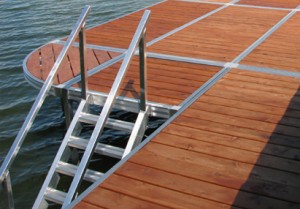
RS4 dock with Dock Steps
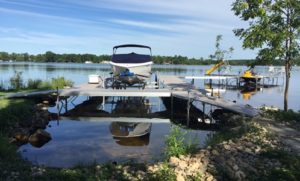
ShoreMaster Dock Configuration
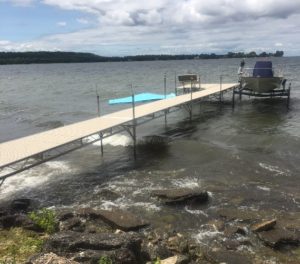
Dock Configurations 2
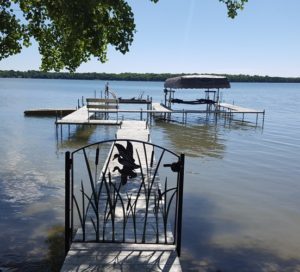
Dock Configuration 3
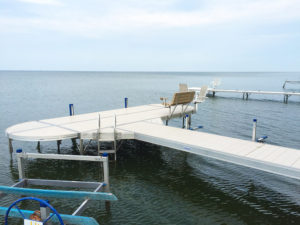
Dock Configuration 4
OR
Design your dock configuration on the ShoreMaster Website
ShoreMaster has a simple dock-builder available online. Its very simple to use. (drag and drop) It handles MOST configurations. Are you having difficulty? We can do it for you. In most cases, we give you a rendition (sometimes hand-drawn), so you can be sure the layout is what you envisioned.
What will I be able to do on a dock?
Fishing – Consider an extra-wide dock section at the end to give you more room to cast and lay out your fishing equipment. Install a bench for more comfort.
Docks are an excellent place for kids to learn from Grandpa. They can relax on the dock and exchange fishing stories and learn a little bit about life.
Try to extend the dock far enough into the water, so you’re next to a weed bed. A dock helps lure fish. Fish like to congregate and seek out cover and protection.
Sports – How about Kayak or paddleboard racks? Why keep carrying your equipment up to the house? Keep it handy and ready for use.
Entertaining – If you regularly party on your dock, you’ll want a dock that is wide enough to accommodate your guests. It must offer plenty of space for moving around. For extra space around a serving table or a bench, consider an additional 4-foot wide dock section. We can add it on to the standard 4-foot wide sections. Consider an inside corner section. It’s great for adding space – and peace of mind. A 90-degree corner can seem precarious.
For more pizazz, ShoreMaster offers a curved design on their truss and rail dock systems. Consider adding a curve to your dock. Go around obstacles like trees and rocks and make a unique dock at the same time. It definitely won’t look like your neighbors.
A rounded dock near the end, at the shoreline or even at the midpoint adds a unique design that only you have. The style is distinctly yours.
Patios
Ninety- five percent of the time the dock layout will include a “patio” area. The patio area requires a section of dock placed parallel or perpendicular to the main dock. Adding one patio dock essentially creates an 8 ft x 8 ft activity area over the water.
What if you add another patio area to the side to make a 12 ft wide x 8 ft long area? This additional “patio” section could be placed alongside the first section OR on the opposite side of the dock. The layout also helps protect your dock in a storm by making it broader and more stable. However, the REAL advantage of these layouts is that you have more working or entertaining area available.
Put a bench or patio set on the patio area to stay dry. Use it to get away from people entering or exiting the water – if they let you.
By the way, who said the patio section of a dock has to be at the far end of the pier? Would it be more functional at the midpoint or even at the shore end?
Watercraft Access:
- Do you launch a boat or jet skis? These functions may need different layouts depending on the depth of water and the draft of your boat or jet ski. They reflect what the owner needs for launching and storing the watercraft.
- A typical layout would likely be the finger dock. The finger dock consists of lengths of pier placed perpendicular to the side of the main dock. The arrangement creates a place for your jet skis or boat.
- The use of a “T,” or “Y” shape can add a distinctive look to your dock. After all, your pier is the focal point of your shoreline. Every visitor will want to go out on your dock.
What accessories will you need for your dock configuration?
- Seating– In the form of furniture sets, chairs or benches.
- Utilities– Water and electricity run under the dock frame.
- Lighting– A.C. power is available, but the preferred method is solar powered lighting. They are typically placed in recessed “dots” in the decking.
- Ladders– On the bay of Green Bay most docks are set high out of the water to protect them from waves. A pivoting ladder will get you out of, or into, the water safely.
- Railing- A railing makes it safe for people having difficulty getting around or those who are unsteady on their feet to access your dock.
- Storage boxes– Skiers, kayakers and paddleboard enthusiasts may want to invest in a dock box to store their equipment. (life jackets, paddles, and beach towels). The storage boxes come in many shapes and sizes – (square, rectangular and triangular to name a few).
To summarize this series – What does a dock cost? It depends!
Missed a part of this series?
Publication dates:
Part 1 – What does a Dock cost?
2 – What type of decking is available?
3 – Which dock configuration should I choose?
Need Help Planning a Dock Configuration For Your Home or Cottage?
Do you have a friend that may be interested in this information? Please share a link to this page with them.
PWS is located at 7325 St. Hwy 57. That’s 1 mile North of County MM (Hwy 42) and 3 miles South of Sturgeon Bay at the Idlewild Road intersection.
Our staff is here year-round to assist you.






















